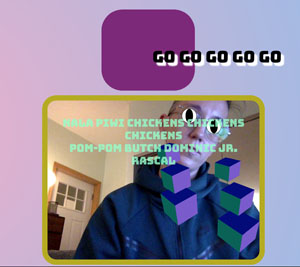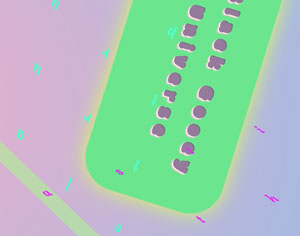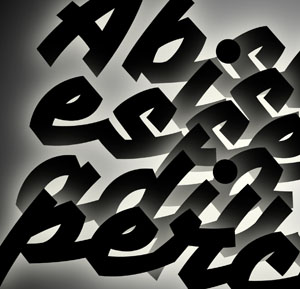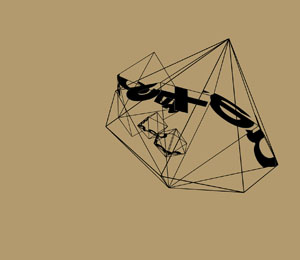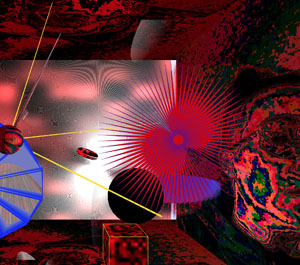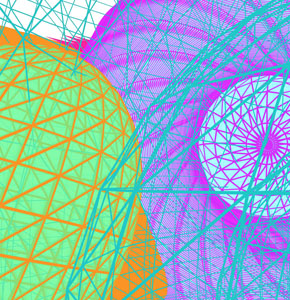DIFFUSED STREAM
We can’t begin to tell you how many times we’ve been in the midst of a
bad connection. Honestly, we have the bars, but the service is just
garbage. If the call isn’t immediately dropped, it’s glitchy and
sporadic, or delays stretch the delivery of our presence. There was even
that time (which time?) that the power went out, leaving us in the dark
without electricity or wifi, forcing us to head back home to finish our
work. Driving through traffic, we saw whole blocks on the northside of
North Ave without power and the weather wasn’t even that bad. Four hours
later, ComEd’s own maps showed outages across the city, some only as
wide as a couple of blocks while others took out entire neighborhoods.
At the time, there was but a mere sprinkle of rain and no thunderstorms
in the forecast.
Often, we are told that weather is the culprit. Extremes in temperature,
rain, and stormy conditions disrupt the operability of telecom masts
that kill our abilities to connect. Decades old cable or untended
construction sites become susceptible to other kinds of dangers,
creating potential problems in the service grid. But as service
providers strive for maximal efficiency without any dips in service,
they rely on technologies specifically designed to maximize the user
experience. Any reports of bad service propell further development of
new signal boosters and telecom infrastructure allowing faster load
times, higher bitrates, and better transfers even when the weather is
bad. In this continual expansion of service, in our desire to have
control of connection immediately, we are reliant on infrastructures
rendered invisible that allow us to call/text/email you right now.
(“Why, you didn’t get my message we sent?”) This reliance on fast paced
data transfers displace our physical presences with proxy servers that
we never get to see. And yet, we continue to be remade as assemblages of
flesh, silicone, and radio waves.
Held within these moments of interruption is the recognition of a system
underneath the substrate of (electrical) power. Perhaps this qualifies
as the new ghosts in the machine, though most likely it’s a structural
issue that needs some resolution. Maybe that’s a different kind of
ghost. Regardless, each of these miniature moments reveal larger
concerns and questions related to access, power, and privilege, moments
that activate our relationships to our surroundings in complex and
nuanced ways.
The more we think through this, the more we understand the need to
change our relationship to the built environment. Not the architectures
made from glass or brick, but the infrastructures hiding underneath and
behind slabs of concrete and steel. Miles of wires, fiber optic cable,
and silicon stretch across these structures, occasionally revealing
remnants as painted rectangles that match the tops of towers or as
tinted globes protruding out from white and black disks at the edges of
buildings. The more we look up, the more we can’t help but notice the
vastness of these architectural accessories indicative of the expansion
of digital economies.
It’s no surprise that social and public spaces are continually, and
increasingly, being penetrated by this digital infrastructure. Looking
to Ruha Benjamin’s collected scholarship in her books The New Jim Code
and her volume of edited essays Captivating Technology: Race, Carceral
Technoscience, and Liberatory Imagination in Everyday Life, we set out
to explore how these infrastructures impact our daily lives, knowing
full well the intersectional stakes that were (and still are) at play.
Beyond the historical and sociological work Benjamin puts forth, we also
wanted to spend time with The Dictionary of Dark Matters published by
the School for Poetic Computation. For us, The Dictionary remains an
intervention in the naming and defining of things while also being a
pathway for shaping the trajectory of the words described.
In looking to these collections of words, ideas, and proposals, we
recognized our inadequacy to parse through this material individually,
given the weight and nature of the content we wanted to cover. To help
navigate these rich provocations, we wanted to develop a space that
allowed us to collectively peel back the devices that constrain our
understanding of ourselves, to move away from fixed systems and instead
cultivate discursive environments that are continually being remade.
Mapping theory and praxis within a working environment, it became
critical for us to devise workshops that were technical and
conversational and that allowed us to develop an intersectional
framework to engage in code from technical and conceptual perspectives.
What emerged was a collection of generous engagement with a thoughtful
group of artists, creative technologists, designers, and curious minds.
We were struck by the commitments of others who collectively thought
through the nuances of carceral technologies, offering anecdotes and
reflections on the ways coded systems are built and sharing how hidden
environments shape the ways we interface with each other and the world.
Held in smaller groups before convening into a larger conversation, we
facilitated a platform for the continuation of discourse surrounding
algorithmic oppression and coded bias. These groups of people divided
over two weekends built conversational interventions, ones that helped
contour the rigidity of theory into materialized instances and
occurrences that became felt and embodied.
As part of these conversations, we introduced skills-based coding
workshops focused on P5.js and CSS animations to activate the
conceptual/verbal/rhetorical work from the collective’s discussions.
Designed for the untrained, these online skill-share trainings were
intended to allow participants the ability to apply theory into praxis,
to consider the ways their designs and conceptual calls for justice
could be encoded into the fabric of visual culture. As educators,
informed by experiences of youth advocacy and social justice activism,
we wanted to enable participants to turn these vocalized expressions
into articulated shapes, designed with code as a way to develop
alternative forms of self-determination. In designing these workshops,
we sought to encourage participants' ability to return these exercises
by eventually contributing works-in-process to another formation of
theory and praxis: an installation accessible through an online
interface that was developed in a physical space of the gallery.
Devised while in residence at ADDS DONNA in Chicago, we wanted to
further allow the collective of disembodied heads to fill the physical
space of a gallery. For us, the fixed architectural form of a room not
only became a visible interface for the activation of what remained
hidden, but it became an opportunity to expand our notions of space
making given the melting of flesh into the expansive networks of digital
culture. Tethered to arrays of communicative technologies built from
digital infrastructures, the site of the gallery allowed us to project a
prototype of collective imagination, one designed to allow us to engage
in the emerging FAQs of carceral technologies without succumbing to the
trappings of historicity.
To be clear, we were not interested in taking up space in the ways of
establishing a settlement (or an occupation even), but as an opportunity
to hold space necessary for our collective survival. Temporary and
amorphous, the site inside the confines of the building became a
strategic location for the cultivation of collective space. Shifting the
existing framework of the given architecture, it was important for us to
play with forms that were disruptive to the ways walls were felt, to
reveal shadow architectures of a room as something inescapable and
persistent, and to underscore ways that built environments become scores
for the choreography of movement. Activating the edges of the room
reminded us that not all that was invisible was without presence.
Features of the room like the shadows cast from hidden ledges or pockets
of light caught in the contours of the curvy wall uncovered other
potential opportunities to play with our cultivation of space.
In our collective experimentation inside and online, we began to trace
the parallels of normalized architecture to encoded systems that have
become entangled with our bodies. While it’s easy for us to take their
presence for granted, particularly as we rely on these structures for
various levels of (perceived) safety, access, and stability, we are led
to forget that these assemblages of metal and concrete structure our
pathways and modes of communication. Their ubiquity envelops us to the
point where our movement becomes contingent on the spatial relationships
we establish within and through the cables laid underneath our feet.
While installing in the space of the gallery, it became clear that the
physical site was an inadequate singular experience. No amount of
translucent material or sculptural interventions could immediately
signify the content of encoded inequity discussed in the workshops.
Instead, we decided that a 360-camera placed in a fixed position would
invite viewers to consider the mediated space of the gallery as a
provocation to understanding the positionality of a forced gaze. Within
this recognition, we wanted to illuminate the future possibilities of
social, physical, and communal space. In this interaction, viewers and
users online have the ability to look into the mediated room on their
own terms and to toggle the angle of the view based on their own modes
of discovery. With a centrally placed camera, we also recognized the
viewer’s inability to move through the space. Disabling the facility of
movement while allowing users the autonomy of vision presented a
different kind of agentive tension, one that immediately called into
question the ways we are allowed to engage in technologies due to the
nature of their design.
It also became apparent that the move to digitality was a conceptually
important one, specifically in the moments where inequity has really
begun to show itself. Not unlike the service outages, we have been
continuously reminded that we are surrounded by inadequate systems, ones
that have over the course of 2020 shown their worst selves in epic
fashion. Within the ongoing struggles against white supremacy and racial
injustice, we also bear witness to the disproportionate effects of
disenfranchisement intersecting with an irresponsibly handled global
pandemic, not to mention the continual degradation of our most precious
environmental resources.
And so on,
and so on,
and so on,
and so on…
We have become enveloped in a world where inequity soars as the number
of billionaires (often in tech industries) climb to an all-time high.
And we continue to remain suspicious of the ways technologies are used
within capitalist frameworks of extraction, ones that force a pursuit of
a better signal uninterrupted by the environmental, political, or
economic consequences set forth by the global pandemic.
An inherently political project, we wanted to internalize these
iterations of collective space making as indicative of communal
abundance: a sort of early experiment in collective mutual aid that
shifts the legibilities of power into a horizontalization of ownership
and collaboration. While this project is never complete - and filled
with many gaps - we wanted to create a situation where the process of
our project was transparent and unmanicured. We wanted to transform the
space of the gallery into a site of layered expressions, a site of
infinite possibilities that relied on input by the collective. Though
using the tools that enable algorithmic oppression to occur, we remained
intentional in how we utilized them as a strategy to begin a process of
reclaimation through the languages used to articulate spatial
expression.
In this layering, we were ecstatic by the messiness of our participants’
collaboration and how language became image, idea, and form. The
conversational relationships established during iterative components of
this work remain central to our understanding of it. It was only in
conversation across the project’s multiple expressions that allowed us
to begin asking: How do we build networks of care? How might we develop
mutual aid across creative uses of technology that might allow us the
capacity to be less reliant on systems that ultimately fail us? How can
we, as a collective, as members of multiple communities, utilize our
individual and collective power to transform our relationships to the
concealed infrastructures of communication and information?
